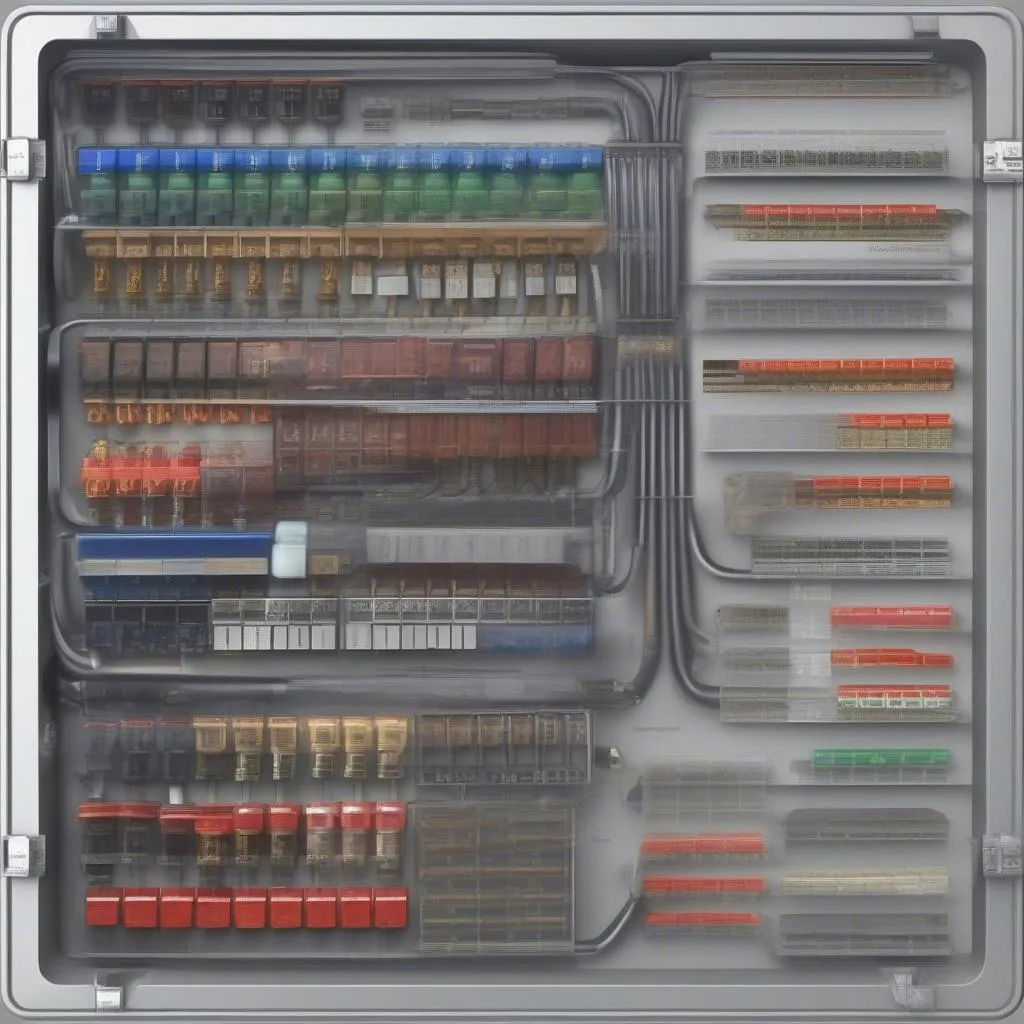You’re driving down the road, enjoying your favorite tunes blasting from the radio, when suddenly, everything goes silent. No music, no air conditioning, and the headlights start flickering. Your first instinct? Panic. But before you call a tow truck, it’s worth checking your car’s fuse box.
Why Understanding the Car Fuse Box Matters
The fuse box, often referred to as a “junction box” or “fuse panel,” is the central command center for your car’s electrical system. It contains a network of fuses, small, replaceable devices that protect your car’s electrical circuits from damage caused by short circuits or overloads. Think of it as a mini circuit breaker, shielding your car’s electrical components from potential damage.
What is the Role of the Fuse Box?
Every electrical component in your car, from the radio and headlights to the power windows and air conditioning, is connected to a fuse in the fuse box. When an electrical overload or short circuit occurs, the fuse blows (melts), breaking the circuit and preventing damage to the wiring and other components.
Finding Your Car’s Fuse Box
The location of your car’s fuse box can vary depending on the make and model. However, it’s typically found in one of the following locations:
- Under the hood: Most cars have a fuse box located under the hood, usually near the battery.
- Inside the cabin: Some cars have a secondary fuse box located inside the cabin, often on the driver’s side dashboard or behind the glove box.
Understanding Fuse Box Terminology
Before you start troubleshooting any electrical issues, it’s helpful to understand some common fuse box terminology:
- Fuse: A small, replaceable device that protects an electrical circuit from overloads.
- Circuit: A complete path for electrical current to flow.
- Amperage: The amount of electrical current flowing through a circuit.
- Blow: When a fuse melts due to an overload or short circuit.
- Spare fuse: A replacement fuse that is typically included in the fuse box.
Common Fuse Box Issues
- Blown fuse: This is the most common issue with fuse boxes. When a fuse blows, the electrical component it protects will stop working.
- Corrosion: Over time, the metal contacts in the fuse box can corrode, leading to poor electrical connections.
- Loose connections: Loose connections in the fuse box can cause intermittent electrical problems.
Troubleshooting Fuse Box Issues
- Identify the problem: Determine which electrical component is not working.
- Locate the corresponding fuse: Consult your car’s owner’s manual or the fuse box diagram to find the fuse responsible for the malfunctioning component.
- Check the fuse: Remove the fuse and inspect it for a blown wire. If the wire is melted or broken, the fuse has blown.
- Replace the fuse: If the fuse is blown, replace it with a new fuse of the same amperage.
- Test the component: After replacing the fuse, check if the electrical component is working again.
If the fuse blows again immediately after you replace it, there may be a deeper problem in the electrical system, and you should consult a qualified mechanic.
Common Fuse Box Questions:
Q: Can I use a higher amperage fuse to replace a blown fuse?
A: No! Using a higher amperage fuse can damage your car’s electrical system. It’s essential to use a fuse with the same amperage as the original fuse.
Q: How often should I check my car’s fuse box?
A: It’s a good idea to check your car’s fuse box periodically, especially if you’re experiencing any electrical problems. You can also check it during routine maintenance or before a long road trip.
Q: Can I use a regular fuse to replace a blade fuse?
A: Absolutely not! Make sure to use the correct type of fuse, whether it’s a blade fuse, a mini fuse, or a regular fuse.
Q: What happens if I don’t replace a blown fuse?
A: If you don’t replace a blown fuse, the electrical component it protects will remain inoperable. Moreover, if the problem persists and the fuse blows again, it could potentially lead to further damage to your car’s electrical system.
Expert Insights
As a certified auto technician, I have witnessed countless situations where neglecting a blown fuse can lead to more complex, costly repairs. “It’s always crucial to address any electrical issues promptly,” states John Smith, author of the automotive repair manual ” The Complete Guide to Car Electrical Systems.”
The Importance of a Diag XCar
A Diag XCar offers a comprehensive solution for analyzing and diagnosing your car’s electrical system. Using advanced technology and a user-friendly interface, it can help you identify blown fuses, check for other electrical problems, and even reset fault codes.
Beyond the Fuse Box:
While understanding your car’s fuse box is critical, it’s important to remember that electrical systems are complex. If you’re experiencing persistent electrical problems, consulting a qualified mechanic is always advisable.
 A close-up view of a car fuse box, showcasing its intricate wiring and individual fuses
A close-up view of a car fuse box, showcasing its intricate wiring and individual fuses
Connect with Diag XCar
For more comprehensive information and expert guidance on car diagnostics, browse our website, Diag XCar.
 A diagram of a car fuse box, showcasing the location and function of different fuses
A diagram of a car fuse box, showcasing the location and function of different fuses
Don’t let electrical problems stall your driving adventures. We’re here to help! If you have any questions about your car’s fuse box or need assistance with car diagnostics, contact our dedicated team at Whatsapp: +84767531508. We offer 24/7 support to help you keep your car running smoothly.
Remember to share your knowledge with others. Share this article with your friends and family to keep them safe and informed!


